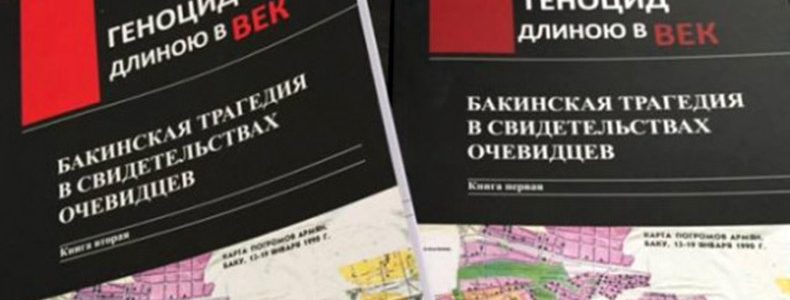The second volume of the collection “Baku tragedy in testimonies of eyewitnesses” was published in Yerevan
The second volume of the collection “Baku tragedy in eyewitness testimonies” was published in Yerevan. It was prepared within the framework of the project “Ordinary Genocide” implemented by the President’s Office of Information and Public Relations.
According to Marina Grigoryan, the project manager and the responsible editor of the collection, the book was the result of the next stage of the “Genocide per century” project, based on a video interview with the Baku Armenians living in the USA. The first volume was presented in January this year, and earlier, in January 2015, was presented a documentary film “Genocide of the length in the century. Black January Baku ». Almost two hundred books of the collection include almost 100 interviews.
“In fact, about 150 refugees from Baku took part in the project. A number of interviews are of a family nature. These 100 “living stories”, 100 evidences of the horror that occurred in Baku more than a quarter of a century ago – an impressive slap in the face of the speaker about their tolerance and peacefulness for Azerbaijan. Those who have all passed after the tragedy of the decade do not disdain to refute and distort the historical truth, forgetting that tens of thousands of its eyewitnesses are alive. As in the first book, these evidences of the former Baku residents and the memories of the many-time expelled, homeland-deprived and property that survived the tragedy of the beginning and the end of the 20th century by Armenians are a convincing confirmation of the permanence of the genocide committed against the Armenian people for a century, ” – said Aysor.am Marina Grigoryan.
According to her, unlike the Sumgait events, relatively few documents, photographs and video materials were preserved about the Baku pogroms. That is why for the first time in a quarter of a century it was decided to record on video and present to the international community interviews with eyewitnesses of the events. The authors of the project set themselves the goal of collecting as many “living stories” as possible, which not only recreate the picture of a large-scale crime, but also shed light on the previously unknown, often sensational pages of the history and tragic outcome of the Armenians of Baku.
Of particular importance from this point of view are the documents that are preserved in the archives of the refugees themselves and are first presented in the second book of the collection. These unique documents testify to the atmosphere of deadly danger and criminal lawlessness, in which the Baku Armenians found themselves in 1988-1990.
“I accuse Azerbaijan” – this idea runs through all the eyewitnesses’ memories, becoming an accusation and a verdict to the state that committed the genocide, “the preface to the collection says. It should also be noted that in the second volume there is evidence of not only Armenians, but also refugees from Baku of other nationalities – Russians and Jews, as well as the story of a Baku Armenian whose mother was an Azerbaijani.
According to Marina Grigoryan, the Information and Public Relations Center of the Office of the President of Armenia intends to continue this ambitious work, whose goal is to preserve and inform the contemporaries about the recent history of the region in order to prevent further acts of violence, genocides and deportations. New films, books and brochures are planned. Collection “The Genocide of the Lent Age. Baku tragedy in eyewitness accounts ” will also be translated into English.
Both books of the collection are also available on the website Karabakhrecords.info.
Let us recall that on January 13-19, 1990, a massive pogrom of the Armenian population was committed in Baku, which culminated in the genocide of Armenians in Azerbaijan in 1988-1990. After the pogroms in Sumgait (February 26-29, 1988), persecutions, beatings, murders with special cruelty, public mockery, pogroms of individual apartments, seizure of property, forced evictions and illegal dismissals from the work of Armenians began in Baku. By January 1990, of the 250,000 community in Baku, there were about 35-40 thousand Armenians – mainly disabled people, elderly and sick people and relatives who looked after them. Since January 13, 1990. Pogroms have become organized, purposeful and massive. There are numerous reports of atrocities and murders committed with exceptional cruelty, including group rape, burning alive, throwing from high-level balconies, dismemberment and decapitation.
The exact number of victims of the Armenian genocide in Baku is still unknown – according to various sources, between 150 and 400 people were killed, hundreds were maimed. The pogroms lasted a week, with total inactivity by the authorities of Azerbaijan and the USSR, internal troops and the numerous Baku garrison of the Soviet Army. Those who managed to avoid death, were subjected to forcible deportation. Only on January 20, 1990, Soviet troops were established in Baku to establish order.
My other posts
Century long Genocide. Black January in Baku

